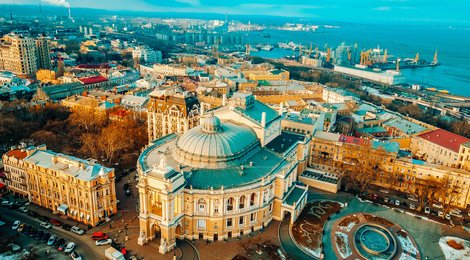Країни
Odesa
The fourth-largest city (2019 pop 1,013,292) in Ukraine and the capital of Odesa oblast. It is a major port on the Black Sea, a commercial, industrial, cultural, and administrative center, and a transportation terminal.Geography. Odesa is situated on a large, virtually ice-free bay on the Black Sea, near the mouths of the Danube River, the Dnister River, the Boh River, and the Dnipro River, which link it with the interior of the country. Most of the city stands on a plateau built of Pleistocene strata of clay and chalk, which are covered with brown clays and loess. The plateau rises 50 m above the Black Sea Lowland and falls abruptly in the east to the sea.
Odesa lies in a zone with a steppe climate, which is moderated by the sea. The average annual temperature is 9.6°C, the average July temperature 22.1°C, and the average January temperature –2.8°C. The annual precipitation is 351 mm, most of which (236 mm) falls during the warm season. There are 285 sunny days per year. Odesa's port freezes over for only 15 days a year, but the thin ice does not impede shipping. Because of the absence of large sources of fresh water nearby, an aqueduct had to be built from the Dnister River to the city/
History. In prehistoric and early historical times the site of present-day Odesa was settled by various peoples and tribes, among them the Cimmerians, Scythians, Sarmatians, and Greeks.
Odesa is an important health resort center. The first resorts were opened there in the 1820s. In 1961 there were 12 resorts, 41 sanatoriums, 17 rest homes, and 3 health pensions. The resorts dot the coast for 70 km south from Fontanka. They include the Khadzhybei, Kuialnyk, and Malodolynsk mud-bathing resorts, Arkadiia, Velykyi Fontan, Chornomorka, and Luzanivka.
The fourth-largest city (2019 pop 1,013,292) in Ukraine and the capital of Odesa oblast. It is a major port on the Black Sea, a commercial, industrial, cultural, and administrative center, and a transportation terminal.Geography. Odesa is situated on a large, virtually ice-free bay on the Black Sea, near the mouths of the Danube River, the Dnister River, the Boh River, and the Dnipro River, which link it with the interior of the country. Most of the city stands on a plateau built of Pleistocene strata of clay and chalk, which are covered with brown clays and loess. The plateau rises 50 m above the Black Sea Lowland and falls abruptly in the east to the sea.
Odesa lies in a zone with a steppe climate, which is moderated by the sea. The average annual temperature is 9.6°C, the average July temperature 22.1°C, and the average January temperature –2.8°C. The annual precipitation is 351 mm, most of which (236 mm) falls during the warm season. There are 285 sunny days per year. Odesa's port freezes over for only 15 days a year, but the thin ice does not impede shipping. Because of the absence of large sources of fresh water nearby, an aqueduct had to be built from the Dnister River to the city/
History. In prehistoric and early historical times the site of present-day Odesa was settled by various peoples and tribes, among them the Cimmerians, Scythians, Sarmatians, and Greeks.
Odesa is an important health resort center. The first resorts were opened there in the 1820s. In 1961 there were 12 resorts, 41 sanatoriums, 17 rest homes, and 3 health pensions. The resorts dot the coast for 70 km south from Fontanka. They include the Khadzhybei, Kuialnyk, and Malodolynsk mud-bathing resorts, Arkadiia, Velykyi Fontan, Chornomorka, and Luzanivka.

 Глянець
Глянець